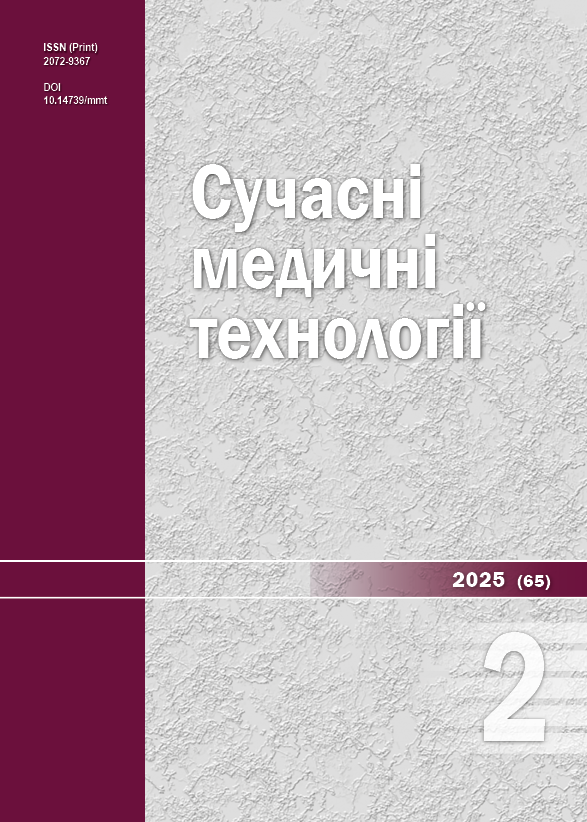The impact of polypharmacy on adherence to pharmacotherapy for coronary heart disease with comorbid conditions: insights from the EUROASPIRE V observational study in Ukraine
DOI:
https://doi.org/10.14739/mmt.2025.2.322403Keywords:
polypharmacy, drug interactions, coronary heart disease, CHD pharmacotherapy, pharmaceutical care, drug compatibilityAbstract
It is known that coronary heart disease (CHD) is the leading cause of mortality among non-communicable diseases worldwide, including in Ukraine. The results of the EUROASPIRE V observational study showed an insufficient level of adherence to treatment in patients with CHD and comorbid conditions across European countries and in Ukraine. Conducting a retrospective analysis of the pharmacotherapy for CHD in patients with hypertension, dyslipidemia, atrial fibrillation, heart failure, type 2 diabetes mellitus, and chronic kidney disease regarding the content, number, and compatibility of prescribed drugs is relevant to determine the impact of polypharmacy on treatment adherence.
Aim. To determine the prevalence of polypharmacy and identify gaps in the rational use of drugs in patients with CHD and comorbid conditions, and to assess the subsequent impact on treatment adherence in the Ukrainian cohort of the EUROASPIRE V study.
Materials and methods. Medical data of patients with CHD and comorbid conditions who participated in the EUROASPIRE V observational study in Ukraine were analysed. Retrospective, statistical, clinical-epidemiological, frequency, ABC analysis, content analysis, comparison, and generalization methods were used.
Results. A significant effect of the number of prescribed drugs on treatment adherence was established (U = 4.895; Z-value = -2.793 without correction; Z-value = -2.844 adjusted). The level of significance (p) without correction was 0.0052 and with correction was 0.0045, indicating the need for the use of fixed combinations. The lack of compatibility among prescribed drugs (Z = 1.71; p = 0.086) in the pharmacotherapy of CHD with comorbid conditions was reliably confirmed, indicating insufficient compliance among doctors, patients, and pharmacists due to the lack of interprofessional interaction within multidisciplinary teams. The relationship between adherence to pharmacotherapy for CHD with comorbid conditions and sex characteristics was also investigated: χ2 = 5.734; df = 1 (for groups of men and women); p ≈ 0.0167. Men (55 %) demonstrated greater adherence to treatment than women (45 %).
Conclusions. The prevalence of polypharmacy in the studied cohort of CHD patients with comorbid conditions was determined to be 76.47 % [CI 95 % 76.47 ± 0.03; p < 0.0001], which can be attributed to the predominantly complex drug model used in pharmacotherapy. The relationship between overall adherence to pharmacotherapy for CHD with comorbid conditions and the presence of drug interactions due to metabolism through the CYP450 isoenzyme 3A4 during the second visit of the studied cohort was reliably confirmed (χ² = 3.97; df = 1; p-value = 0.0462). However, there was a positive trend in the use of target doses of drugs after the correction of pharmacotherapy by the staff of the Department of Cardiology (1st visit – 27.57 % and 2nd visit – 13.57 %).
References
Yurochko T, Skipalskyi A, Kurylo I, Dumcheva A. Pokrashchennia pokaznykiv z neinfektsiinykh zakhvoriuvan: bariery ta mozhlyvosti systemy okhorony zdorovia v Ukraini. Analitychnyi zvit [Improving non-communicable disease indicators: barriers and opportunities for the health care system in Ukraine. Analytical report]. Kyiv; 2023. Ukrainian. Available from: https://ekmair.ukma.edu.ua/handle/123456789/31664
Corica B, Romiti GF, Boriani G, Olshansky B, Chao TF, Huisman MV, et al. Patterns of pharmacological treatment in patients with atrial fibrillation: an analysis from the prospective GLORIA-AF Registry Phase III. BMC Med. 2025;23(1):27. doi: https://doi.org/10.1186/s12916-025-03858-w
Asiimwe IG, Pirmohamed M. Drug-Drug-Gene Interactions in Cardiovascular Medicine. Pharmgenomics Pers Med. 2022;15:879-911. doi: https://doi.org/10.2147/PGPM.S338601
Diaconu CC, Cozma MA, Dobrică EC, Gheorghe G, Jichitu A, Ionescu VA, et al. Polypharmacy in the Management of Arterial Hypertension-Friend or Foe? Medicina (Kaunas). 2021;57(12):1288. doi: https://doi.org/10.3390/medicina57121288
Al-Azayzih A, Kanaan RJ, Altawalbeh SM, Al-Qerem W, Smadi S. Medication Adherence and Its Associated Determinants in Older Adults with Type 2 Diabetes and Cardiovascular Comorbidities. Patient Prefer Adherence. 2023;17:3107-18. doi: https://doi.org/10.2147/PPA.S437013
Marx N, Federici M, Schütt K, Müller-Wieland D, Ajjan RA, Antunes MJ, et al. 2023 ESC Guidelines for the management of cardiovascular disease in patients with diabetes. Eur Heart J. 2023;44(39):4043-140. doi: https://doi.org/10.1093/eurheartj/ehad192
Joseph JJ, Deedwania P, Acharya T, Aguilar D, Bhatt DL, Chyun DA, et al. Comprehensive Management of Cardiovascular Risk Factors for Adults With Type 2 Diabetes: A Scientific Statement From the American Heart Association. Circulation. 2022;145(9):e722-59. doi: https://doi.org/10.1161/CIR.0000000000001040
Ministry of Health of Ukraine. Unifikovanyi klinichnyi protokol pervynnoi, vtorynnoi (spetsializovaanoi) ta tretynnoi (vysokospetsializovanoi) medychnoi dopomohy “Stabilna ishemichna khvoroba sertsia” [Unified clinical protocol for primary, secondary (specialized) and tertiary (highly specialized) medical care “Stable ischemic heart disease”]. 2021. Available from: https://www.dec.gov.ua/wp-content/uploads/2021/12/2021_2857_ykpmd_stabihs.pdf
De Bacquer D, Jennings CS, Mirrakhimov E, Lovic D, Bruthans J, De Smedt D, et al. Potential for optimizing management of obesity in the secondary prevention of coronary heart disease. Eur Heart J Qual Care Clin Outcomes. 2022;8(5):568-76. doi: https://doi.org/10.1093/ehjqcco/qcab043
Vynckier P, Kotseva K, Gevaert S, De Bacquer D, De Smedt D; EUROASPIRE V Investigators. Gender differences in cardiovascular risk factor awareness: Results from the ESC EORP EUROASPIRE V Registry. Int J Cardiol. 2022;352:152-7. doi: https://doi.org/10.1016/j.ijcard.2022.01.059
Reiner Ž, De Sutter J, Ryden L, Mirrakhimov E, Pogosova N, Dolzhenko M, et al. Peripheral arterial disease and intermittent claudication in coronary heart disease patients. Int J Cardiol. 2021;322:227-32. doi: https://doi.org/10.1016/j.ijcard.2020.09.004
McEvoy JW, McCarthy CP, Bruno RM, Brouwers S, Canavan MD, Ceconi C, et al. 2024 ESC Guidelines for the management of elevated blood pressure and hypertension. Eur Heart J. 2024;45(38):3912-4018. doi: https://doi.org/10.1093/eurheartj/ehae178
Van Gelder IC, Rienstra M, Bunting KV, Casado-Arroyo R, Caso V, Crijns HJ, et al. 2024 ESC Guidelines for the management of atrial fibrillation developed in collaboration with the European Association for Cardio-Thoracic Surgery (EACTS). Eur Heart J. 2024;45(36):3314-414. doi: https://doi.org/10.1093/eurheartj/ehae176
Vrints C, Andreotti F, Koskinas KC, Rossello X, Adamo M, Ainslie J, et al. 2024 ESC Guidelines for the management of chronic coronary syndromes. Eur Heart J. 2024;45(36):3415-537. doi: https://doi.org/10.1093/eurheartj/ehae177
McDonagh TA, Metra M, Adamo M, Gardner RS, Baumbach A, Böhm M, et al. 2023 Focused Update of the 2021 ESC Guidelines for the diagnosis and treatment of acute and chronic heart failure. Eur Heart J. 2023;44(37):3627-39. doi: https://doi.org/10.1093/eurheartj/ehad195
Medication without harm: policy brief. Geneva: World Health Organization; 2023. Licence: CC BY-NC-SA 3.0 IGO.
Kim J, De Jesus O. Medication Routes of Administration. [Updated 2023 Aug 23]. In: StatPearls [Internet]. Treasure Island (FL): StatPearls Publishing; 2025 Jan-. Available from: https://www.ncbi.nlm.nih.gov/books/NBK568677/
Bilousova N. [Justification for expanding the pharmacist’s role in the prevention of coronary heart disease at secondary and tertiary levels of medical care. psych-health]. Modern medicine, pharmacy and psychological health. 2024;(3):41-50. Ukrainian. doi: https://doi.org/10.32689/2663-0672-2024-3-7
Bilousova NA. Primary prevention of a coronary heart disease within the structure of pharmaceutical care provision: functional role fulfillment of the pharmacist. Farmatsevtychnyi chasopys. 2024;(3):42-52. Ukrainian. doi: https://doi.org/10.11603/2312-0967.2024.3.14862
Ungethüm K, Wiedmann S, Wagner M, Leyh R, Ertl G, Frantz S, et al. Secondary prevention in diabetic and nondiabetic coronary heart disease patients: Insights from the German subset of the hospital arm of the EUROASPIRE IV and V surveys. Clin Res Cardiol. 2023;112(2):285-98. doi: https://doi.org/10.1007/s00392-022-02093-0
Marques-Vidal P, Jankowski P, Reiner Ž, De Bacquer D, Kotseva K; EUROASPIRE EUROASPIRE V collaborators. Dietary management of patients at high risk for cardiovascular disease; EUROASPIRE V. Clin Nutr ESPEN. 2023;55:144-50. doi: https://doi.org/10.1016/j.clnesp.2023.03.005
Ferrannini G, Tuomilehto J, De Backer G, Kotseva K, Mellbin L, Schnell O, et al. Dysglycaemia screening and its prognostic impact in patients with coronary artery disease: experiences from the EUROASPIRE IV and V cohort studies. Lancet Diabetes Endocrinol. 2024;12(11):790-8. doi: https://doi.org/10.1016/S2213-8587(24)00201-8
Kotseva K, De Bacquer G, De Backer D, Rydén L, Hoes A, Grobbee D, et al. Primary prevention efforts are poorly developed in people at high cardiovascular risk: A report from the European Society of Cardiology EURObservational Research Programme EUROASPIRE V survey in 16 European countries. Eur J Prev Cardiol. 2021 Apr;28(4):370–9. doi: https://doi.org/10.1177/2047487320908698
American Diabetes Association Professional Practice Committee. 10. Cardiovascular Disease and Risk Management: Standards of Care in Diabetes-2024. Diabetes Care. 2024;47(Suppl 1):S179-S218. doi: https://doi.org/10.2337/dc24-S010
Vu NT, Song YM, Tran QT, Yun HY, Kim SK, Chae JW, et al. Beyond the Michaelis-Menten: Accurate Prediction of Drug Interactions Through Cytochrome P450 3A4 Induction. Clin Pharmacol Ther. 2023;113(5):1048-57. doi: https://doi.org/10.1002/cpt.2824
Tesfaye W, Peterson G. Self-reported medication adherence measurement tools: Some options to avoid a legal minefield. J Clin Pharm Ther. 2022;47(3):363-8. doi: https://doi.org/10.1111/jcpt.13515
Find Drugs & Conditions [Internet]. Drugs.com. [cited 2024 Jan 4]. Available from: https://www.drugs.com
Kardas P, Urbański F, Lichwierowicz A, Chudzyńska E, Kardas G, Czech M. Prevalence and Age Structure of Polypharmacy in Poland: Results of the Analysis of the National Real-World Database of 38 Million Citizens. Front Pharmacol. 2021;12:655364. doi: https://doi.org/10.3389/fphar.2021.655364
Kurczewska-Michalak M, Lewek P, Jankowska-Polańska B, Giardini A, Granata N, Maffoni M, et al. Polypharmacy Management in the Older Adults: A Scoping Review of Available Interventions. Front Pharmacol. 2021;12:734045. doi: https://doi.org/10.3389/fphar.2021.734045
Coca A, Castellano JM, Camafort M, Fuster V. Polypill in cardiovascular disease prevention: recent advances. Pol Arch Intern Med. 2023;133(3):16460. doi: https://doi.org/10.20452/pamw.16460
Salim H, Musmar B, Saifi M, Ayyad M, Ruzieh M, Azar J, et al. The Impact of Polypill on Adherence and Cardiovascular Outcomes: A Comprehensive Systematic Review with Meta-Analysis. Curr Cardiol Rev. 2024;20(2):61-71. doi: https://doi.org/10.2174/011573403X283174240110025442
Mourikis P, Polzin A. Dual-Antiplatelet Therapy After Percutaneous Coronary Intervention: How Short Is Too Short? J Am Heart Assoc. 2023;12(2):e028775. doi: https://doi.org/10.1161/JAHA.122.028775
Downloads
Additional Files
Published
How to Cite
Issue
Section
License
Copyright (c) 2025 M. M. Dolzhenko, N. A. Bilousova, L. I. Yakovenko, V. A. Nesukai, N. A. Kozhukharyova

This work is licensed under a Creative Commons Attribution-NonCommercial 4.0 International License.
The work is provided under the terms of the Public Offer and of Creative Commons Attribution-NonCommercial 4.0 International (CC BY-NC 4.0). This license allows an unlimited number of persons to reproduce and share the Licensed Material in all media and formats. Any use of the Licensed Material shall contain an identification of its Creator(s) and must be for non-commercial purposes only.














